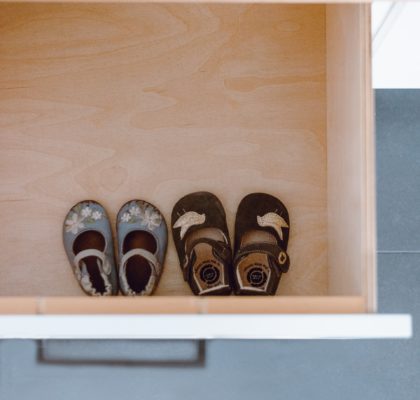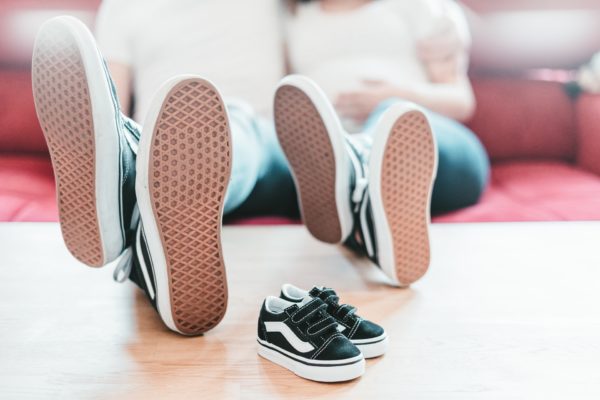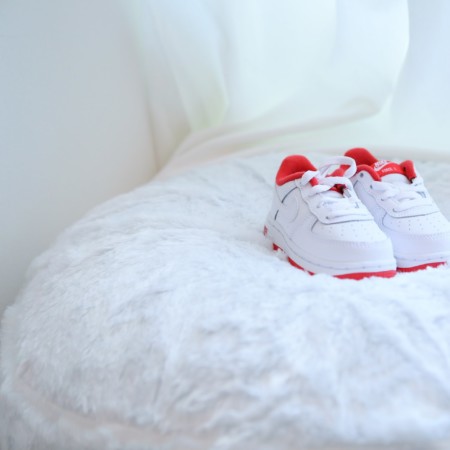Arguably one of your baby’s cutest features, it might seem a shame to cover up those chubby toes in a pair of baby shoes; but once your little one starts walking, their first pair of baby shoes will support and protect them as they get to grips with it!
Knowing how to buy baby shoes when it’s your first time can be tricky – baby shoe sizes vary between countries and brands, and how do you decide between Velcro fastenings or shoelaces?
Our guide is here to help: read on to find out how to buy the perfect pair of shoes for your tot.
When should your baby get their first shoes?
In general, you should buy your baby their first pair of shoes once they begin walking.
In order to let baby’s feet develop and grow as they should, it’s best to keep wear time to a minimum when they’re under one year old. Pop shoes on for chilly strolls, when your baby is beginning to practice standing or any other time their tiny feet need some extra protection. Babies don’t actually need shoes until they begin walking, but lightweight, soft soled shoes can help keep your baby’s toes warm – and slippery socks in place!
Once your baby begins walking around the house, you can stick to soft soled shoes for the time being – they’ll provide more than enough protection for most flooring, and in most cases you can let your baby practice walking indoors barefoot so they have plenty of natural grip.
When your baby begins walking outdoors, it’s time to invest in harder soled shoes that will protect their delicate feet properly!

What are the best first shoes for my baby?
When shopping for a baby’s first pair of shoes, there are a few things to bear in mind.
Support
As a general rule of thumb, if your baby is walking unaided on outdoor ground, go for harder soles with more support! Soles should be flexible but offer plenty of grip to prevent skidding and slipping.
You’ll want to choose shoes that mould well to your baby’s feet, providing support at both the ankles and soles.
Fastenings – Velcro, straps or shoelaces?
Choosing which fastening is best comes down to two things: personal preference and how your baby interacts with their shoes.
If they tend to pull off socks and shoes every time they get the chance, then Velcro may not be the best choice – it’ll be much easier for them to escape their shoes when you’re not looking. The same goes for straps, elasticated or otherwise – it can be easy for little ones to slip them off.
Choosing shoelaces instead should ensure shoes remain on feet at all times!
If your baby isn’t much of an escape artist, then Velcro or elasticated straps can be a great choice as it’s quick and easy for you to get their shoes on.
It’s important to make sure whatever fastening you go for is providing enough support for your baby’s feet, too; loose straps can cause shoes to slip and slide on feet and present a real hazard for your baby as they’re walking.
Getting the right fit
One of the most crucial – and confusing – parts of choosing baby shoes is sizing.
Your baby will be most comfortable, safe and supported in shoes that fit properly. Ill-fitting shoes can be a hindrance for babies and toddlers learning to walk, not to mention a danger!
Below, we’ll take a deeper look into how to get the right fit for your little one’s shoes.

Toddler & baby shoe sizes – how to choose the right fit
Thankfully, many baby shoe sizes now come by age. For brands that don’t use age to determine sizing, it’s best to measure your baby’s feet and match your results to the brand’s own size guide.
To measure your baby’s feet, all you need to do is the following:
- Have your baby stand on their feet on a blank piece of paper – support them if they need it!
- Mark where their big toe is (or their longest toe!) and where their heel is on the sheet of paper.
- Measure between these two marks – this is the length.
- Mark the widest point on either side of their foot on the sheet of paper.
- Measure between these two marks – this is the width.
- Do this for each foot – their measurements might differ on each foot!
It’s best to measure your baby’s feet in the afternoon; feet can swell during the day, so this is when they’ll be at their biggest. There’s nothing worse than cramped little toes in shoes that are too small!
| UK Size | EU size | Foot Length |
| 3 | 12-18 Months | 11.8cm |
| 2 | 6-12 Months | 11.2cm |
| 1 | 3-6 Months | 10.6cm |
| 0 | 0-3 Months | 10cm |
Sizes can vary from brand to brand, but our baby shoe size table will give you a general idea of what to look for.
So once you’ve bought your shoes, how can you tell if the fit is correct?
Shoe width
You should be able to comfortably fit your finger in between the tongue of the shoe and your baby’s foot.
Shoes should be snug on the ankle in order to provide plenty of support, but not so tight they cut into your baby’s delicate skin. They also shouldn’t be too loose; just a tiny gap between the shoe and your baby’s ankle should be just right.
Of course, babies tend to have chubby feet (it’s what makes them so irresistibly cute) so it can be hard to get shoes that are a comfortable width and still a good fit on the ankle.
In this case, it’s best to choose shoes with fastenings at the ankles – this should allow you to size up to accommodate any chub, but still tighten the shoe on the ankle for support.
Shoe length
Shoes that are too small can cause your baby’s toes to be squashed and cramped in the shoe; on the flip side, shoes that are too big can cause the toe of the shoe to be flappy and bend too much as your baby walks.
Toes should have some wiggle room at the top of the shoe; to determine if your baby’s tiny toes have enough space, use the tried and tested method of pressing down on the toe of the shoe while they’re wearing it. There should be a gap of about a quarter of an inch between their biggest toe and the tip of the shoe.
Similarly, the heel needs to be a comfortable fit. Shoes that are too large will cause your baby’s foot to slip out at the heel, whilst shoes that are too small can dig in and cut the back of your baby’s ankles.
You should be able to squeeze your finger between the heel and your baby’s foot!
Shopping for baby or toddler shoes?
We’ve got you covered! Discover our range of adorable shoes for tiny toes today.

